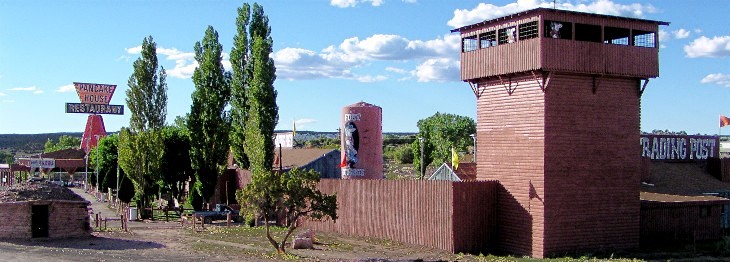| Bankruptcy & Debt Information | Around ARIZONA Home |
 |
| Fort Courage in Houck was inspired by the television comedy F-Troup (1965-1967). 9-03. |
Houck in 1946. Jack D. Rittenhouse's 1946 A Guide Book to Highway 66 lists the only two establishments in Houck: The White Mountain Trading Post {which includes a post office), and a small curio shop. He specifies that gas and groceries are available. Rittenhouse goes on to describe the Native Americans found there: "Navajos are nearly always hanging around the trading post, drinking the soda pop they enjoy. The Navajos are a quiet tribe, whose deft ability in silverwork made them useful in many war plants requiring fine assembly work during the war. They are not allowed to vote, but were subject to the draft during the war." Disenfranchisement. Of all the changes which have occurred along Route 66, the last sentence in the Rittenhouse description illustrates the one of the greatest significance. There has been much discussion of the disenfranchisement blacks and women in America, but the withholding of the right to vote from the Indian population has been much further removed from the consciousness of most Americans.
Blacks were formally enfranchised in 1870 by the Fifteenth Amendment. In 1920 women finally received the right to vote by the Nineteenth Amendment. There was no one act which enfranchised Indians. Instead, Native Americans gradually gained the right to vote depending upon the restrictions in the various states in which they resided. Colorado, Montana, Nebraska, Oregon, South Dakota, and Wyoming required that one must be a citizen to vote. In those states, Indians were considered citizens of their tribe, not of the country or state, and were therefore denied the right to vote until Congress passed the Indian Citizenship Act in 1924. California, Minnesota, North Dakota, Oklahoma, and Wisconsin required that voters be "civilized," and some courts would conclude that Indians who had not adopted the white man's ways by moving off the reservation were not "civilized." Idaho, New Mexico, and Washington, disqualified "Indians not taxed" from voting. Arizona, Nevada, and Utah, had the most stringent restrictions, requiring that voters be citizens, residents and taxpayers. Arizona Indians get the vote. The Indians around Houck "drinking the soda pop they enjoy" did not have the right to vote until 1948. In 1928, the Arizona Supreme Court considered the Indian vote in the case of Porter v. Hall [34 Ariz. 308, 271 P. 211 (1928)]. The court found that Indians on the reservation were under a "federal guardianship" which was equivalent to "persons under disability," a status which barred them from voting. Twenty years the Arizona court reversed its position in Harrison v. Laveen [67 Ariz. 337, 196 P.2d 456 (1948)], finally enfranchising the state's Native American population. As with black voters, even when the vote appeared to have been granted by law other tactics such as literacy tests, poll taxes, and intimidation were used to restrict Indian access to the polls. It was not until the Voting Rights Act of 1965, which was aimed at enfranchising the black voter, that such practices denying the vote were declared illegal. Later amendments to the act added provisions aimed at preserving the voting rights of Native Americans.
|
||||||||||||
|
|
||||||||||||
|
||||||||||||